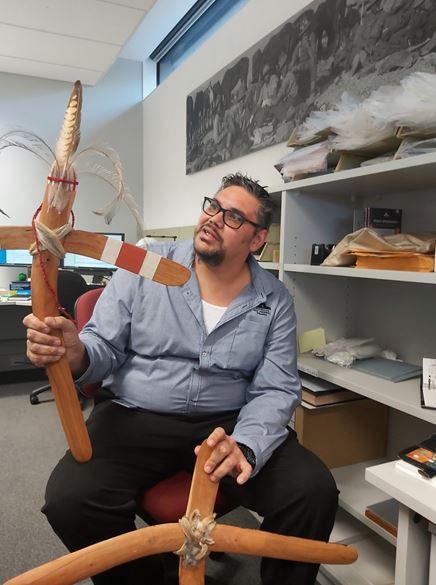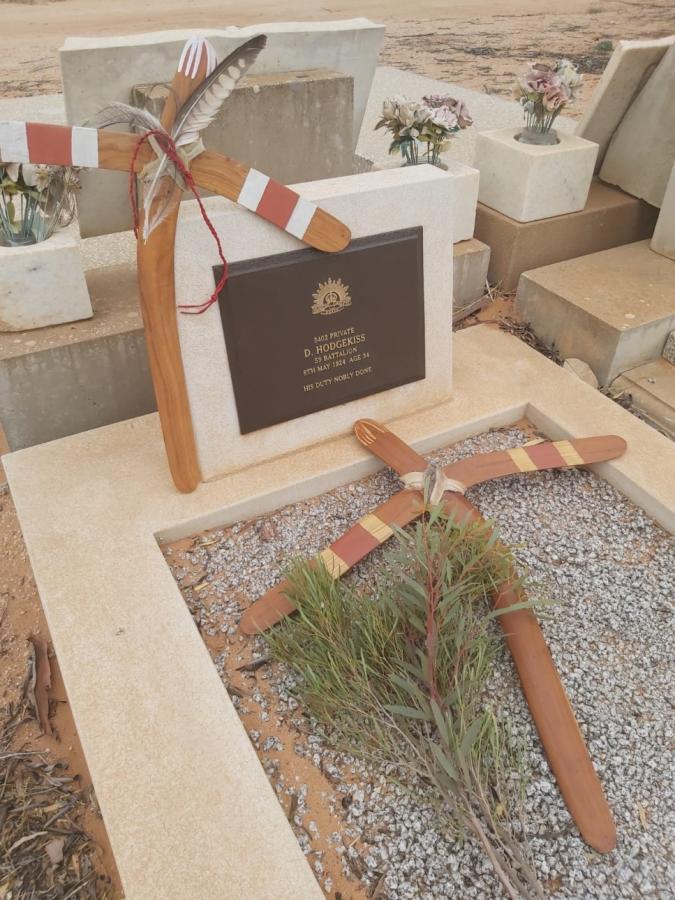Remembering Warrior Spirit
Paul Hingston, a Warumungu man, Indigenous health nurse and former employee of the Australian War Memorial, is committed to his remote community in the Barkly region of the Northern Territory. Providing a solid role model, he seeks to arouse curiosity in young people, give inspiration to those who crave it, and trace stories of reconciliation and unison in Australia from the trenches of the Great War.
“The Barkly region is particularly badly affected by youth suicide, violence and a deep sense of hopelessness. This is my country. By bringing the stories of proud servicemen and women to kids I hope to ignite interest, inspire learning and hope.”
Last year, Paul’s Warumungu mob and members of the Aluwwaru, Jingili and Walpri people made kayin (angled throwing sticks commonly known as boomerang) and held an overnight appeasement ceremony on country. Limbs from a hardwood tree were cut, cured and made into kayin, then bound together into a cross with wallaby hide, and decorated with paint and feathers. An overnight singing ceremony infused warrior spirit into the two kayin.

Paul Hingston brought the two crossed kayin to the Memorial in Canberra.
When the First World War broke out “Aboriginals, half-castes, or men with Asiatic blood” were not permitted to enlist. Despite this, the Australian War Memorial estimates about 1,000 Indigenous Australians fought in the First World War. Mid-way through the war, when recruits were harder to find, restrictions were cautiously modified to accept men who had one parent of European origin.
Daniel Hodgekiss grew up on an Anglican mission station in Port Willunga South Australia. A Ngarrindjeri man and the eldest of six children, Hodgekiss worked as a labourer, shearer and fireman before enlisting in the AIF at Mildura on 28 February 1916. Allotted to the 59th infantry battalion, he embarked for active service in early April, marching in to his unit in France on 8 October 1916.
The 59th battalion was created as part of the doubling of the AIF in Egypt after the withdrawal from Gallipoli. Private Daniel Hodgekiss is pictured on the far right in the second row of D Company, 59th Battalion, c. 1918 E03810
In early 1918, the German army launched the Spring Offensive in an attempt to achieve final victory in the First World War. Private Daniel Hodgekiss was among thousands of Australian soldiers from the 15th Brigade who formed up in skirmish order in a small valley north-west of Villers-Bretonneux. The battle began on 24April with an artillery barrage of high explosive and gas shells . After capturing its objective, Hodgekiss’s battalion came under heavy fire, pinned down by a German machine-gun nest firing from beside a haystack. A number of Australians were killed, and part of the line were forced to ground until Private Daniel Hodgekiss ran around the stack and killed the gunner. This action was recognised and recorded in Charles Bean’s official history, but no medal was ever recommended.
It is not known precisely what Hodgekiss’s experiences in the trenches were – as an Indigenous man he was paid the same wage as non-Indigenous soldiers and served under the same conditions as other men in the AIF. He suffered sickness and wounding as almost all soldiers on the Western Front did; in his first winter, Hodgekiss endured hernia, severe trench foot, bunions and bronchitis. In mid-1918 he sustained a serious shell wound to the thigh and scrotum requiring months of hospitalisation.
The war ended and Hodgekiss came home in August 1919. In his absence both parents and four of his siblings had died – perhaps due to social and economic exclusion, inadequate nutrition or the introduction of new diseases.
Still suffering the effects of trench foot and his wounding, Daniel Hodgekiss returned to a racially divided Australia. He died less than five years later in poverty, obscurity and without family; he was 34. Hodgekiss was buried at Nichols Point cemetery Mildura in a grave without a headstone, marker or nameplate. For 88 years his grave remained unmarked until a local historian enlisted the help of the Mildura RSL and the Office of Australian War Graves. In 2012 a modest headstone was placed to mark the life and service of Daniel Hodgekiss, ‘His Duty Nobly Done’.

On a blisteringly hot day in January 2020 an employee of the AWM took the kayin from Canberra to Mildura. Both the Warumungu mob’s kayin crosses were laid to rest on Daniel Hodgekiss’s grave overnight. One kayin cross remains there, the other has been returned to the Australian War Memorial.
Not far from Nichols Point cemetery at Henderson Park, a commemorative plaque to honour Aboriginal and Torres Strait Islander soldiers reads in part, “Our warriors fought for our land with bravery and courage; for our people, our rights and our country; in the past, the present and for the future. Aboriginal and Torres Strait Islander service men and women enlisted for the opportunity to be treated as equals, to defeat racism and foster lasting mateship. In the trenches they found it.”
Reconciliation is about strengthening relationships between Aboriginal and Torres Strait Islander peoples and non-Indigenous peoples, for the benefit of all Australians.
